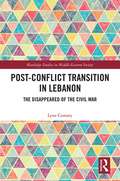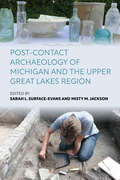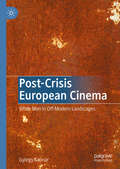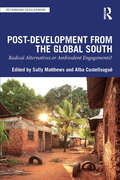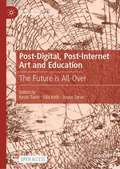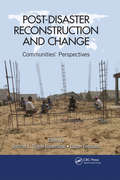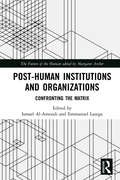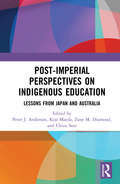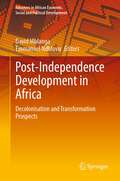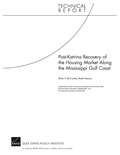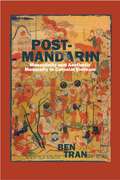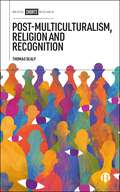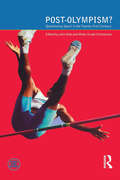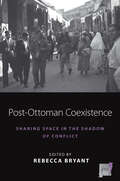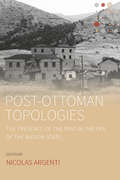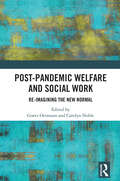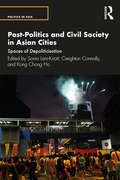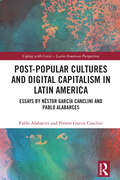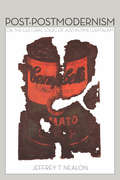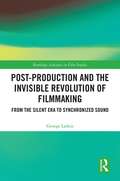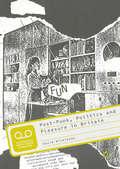- Table View
- List View
Post-Conflict Transition in Lebanon: The Disappeared of the Civil War (Routledge Studies in Middle Eastern Society)
by Lyna ComatyAddressing one of the most pressing issues of the Lebanese Civil War (1975-1990) that is still unresolved almost 30 years later, this book adopts a political, sociological, and anthropological approach to look at periods of transition from conflict to peace in Lebanon. Inducing a set of questions about the social and political system, the post-conflict state has been pushing for a politics of amnesty and amnesia. The case study delves into the notion of transition from conflict to peace in Lebanon by looking in the case of the estimated 17,000 people who disappeared during the Civil War. Using the concept of liminality to understand the evolution of the issue over the years, the book follows the trajectory of the relatives of the missing, who have formed a communitas – a group sharing strong feelings of comradeship and brother/sisterhood by virtue of finding themselves in the same situation. Offering a novel way of looking at transitions, the book is a significant contribution to peace studies, and it will be an interest of students and academics working in human rights, political science, and the Middle East disciplines.
Post-Contact Archaeology of Michigan and the Upper Great Lakes Region
by Misty M. Jackson Sarah L. Surface-EvansAn updated review of post-contact archaeology in the Upper Great Lakes region was long overdue. In this comprehensive reassessment of recent and ongoing developments in the field, Post-Contact Archaeology of Michigan and the Upper Great Lakes Region examines the breadth and diversity of the area’s archaeological sites, highlighting the discoveries that are reshaping our understanding of post-contact archaeology. Gathering case studies that range from terrestrial and underwater cultural sites, to the period of the earliest European settlement to the present day, this volume spotlights how deeply interconnected excavation of the past, and current social justice initiatives are.
Post-Crisis European Cinema: White Men in Off-Modern Landscapes
by György KalmárThis book explores the cinematic representations of the pervasive socio-cultural change that the 21st century brought to Europe and the world. Discussing films such as I, Daniel Blake, Cold War and Jupiter’s Moon, it puts distinctively “post-crisis”, gendered representations in a complex, theoretically informed and socially committed interdisciplinary perspective that maps the newly emerging formations of masculinity at a time of rapid socio-economic transition. Kalmar argues that the series of crises that started with the 9/11 terrorist attacks changed some of our fundamental expectations about history, debunked many of our grand narratives, and thus changed the cultural logic of our (thoroughly globalized) civilization. The book focuses on the ways cinema reflects, interprets and shapes a rapidly changing world: the hot issues of the times, the new formations of identity, and the shifts in cinematic representation. This is an interdisciplinary research that is equally interested in what new the 21st century brought about, most specifically to Europe and to its white men, as in film and its responses to these socio-cultural changes.
Post-Development from the Global South: Radical Alternatives or Ambivalent Engagements? (Rethinking Development)
by Sally MatthewsPost-development advocates and decolonial thinkers are calling for radical alternatives to development, but how do these ideals sit with the day-to-day reality of marginalised communities struggling with poverty, precarity, and the deprivation of human rights?This book investigates how post-development alternatives are being understood and negotiated on the ground in the Global South. Indigenous concepts and practices attributed to people in the Global South are seen by post-development thinkers as offering transformative alternatives to dominant development models of progress and economic growth. For example, buen vivir from particular regions of South America points to a ‘culture of life’ and ubuntu in Southern Africa emphasises human connectedness and mutuality. Such terms are associated with social and environmental sustainability, and a greater connection to Southern epistemologies. Drawing on extensive fieldwork, this book takes us directly to Global South communities from around the world, to consider the complex ways in which they negotiate the ideas and practices associated with (post)development, and their views on the supposed indigenous alternatives. The book encourages a contextual approach that embraces the tensions and contradictions that exist within different communities.Taking the reader from abstract post-development theory right into the heart of communities directly impacted by development, this book will be an important guide for students, researchers and practitioners looking for better ways to address the desires and aspirations of marginalised communities in the Global South.
Post-Digital, Post-Internet Art and Education: The Future is All-Over (Palgrave Studies in Educational Futures)
by Kevin Tavin Gila Kolb Juuso TervoThis open access edited volume provides theoretical, practical, and historical perspectives on art and education in a post-digital, post-internet era. Recently, these terms have been attached to artworks, artists, exhibitions, and educational practices that deal with the relationships between online and offline, digital and physical, and material and immaterial. By taking the current socio-technological conditions of the post-digital and the post-internet seriously, contributors challenge fixed narratives and field-specific ownership of these terms, as well as explore their potential and possible shortcomings when discussing art and education. Chapters also recognize historical forebears of digital art and education while critically assessing art, media, and other realms of engagement. This book encourages readers to explore what kind of educational futures might a post-digital, post-internet era engender.
Post-Disaster Reconstruction and Change: Communities' Perspectives
by Jennifer E. Duyne Barenstein Esther LeemannSuccessful recovery following a disaster depends upon transcending the disciplinary divides of architecture, engineering, and planning and emphasizing the importance of community perspectives in the post-disaster reconstruction process. Effective results in community recovery mandate that we holistically examine the complex interrelationship betwee
Post-Fukushima Activism: Politics and Knowledge in the Age of Precarity (Routledge Innovations in Political Theory)
by Azumi TamuraPolitical disillusionment is widespread in contemporary society. In Japan, the search for the ‘outside’ of a stagnant reality sometimes leads marginalised young people to a disastrous image of social change. The Fukushima nuclear disaster was the realisation of such an image, triggering the largest wave of activism since the 1960s. The disaster revealed the interconnected nature of contemporary society. The protesters regretted that their past indifference to politics prefigured such a catastrophe and became motivated to protest in the streets. They did not share any totalising ideology or predetermined collective identity. Instead, the activism provided a space for each body to encounter others who forced them to feel and think, which also introduced an ethical dimension to their politics. In this book, Azumi Tamura proposes a concept of politics as a series of endless experiments based on creative responses to unexpected forces. Instead of searching for a transcendental reference for politics, she investigates an immanent force within individuals that motivates them to become involved in political action. Referencing Deleuzian philosophy, Tamura provides a different epistemological and ontological approach to the social movement studies. She suggests social movements themselves generate knowledge about how one may live better in a complex society and where our lives are exposed to uncertainty. This knowledge is neither empirical knowledge, nor normative political theory of ‘how we should live’. Instead, social movements bring affective knowledge into politics as they offer a space for experimenting with ‘how we might live.’ The encounter with such knowledge galvanizes our desire for ‘how we want to live’ and encourages new experiments.
Post-Genome Biology of Primates
by Hiroo Imai Yasuhiro Go Hirohisa HiraiIn 2001, first reports of the human draft genome were published. Since then, genomes of many other organisms have been sequenced, including several primate species: the chimpanzee, rhesus macaque, gorilla, orangutan, gibbon, baboon, marmoset, tarsier, galago, lemur, and more recently Neanderthals. In a new era of "post-genome biology", scientists now have the vast amount of information revealed by genome research to confront one of the most challenging, fundamental questions in primatology and anthropology: What makes us human? This volume comprises a collection of articles on a variety of topics relevant to primate genomes, including evolution, human origins, genome structure, chromosome genomics, and bioinformatics. The book covers the cutting-edge research in molecular primatology and provides great insights into the functional diversity of primates. This valuable collection will benefit researchers and students, including primatologists, anthropologists, molecular biologists, evolutionary biologists, and animal behaviorists.
Post-Human Futures: Human Enhancement, Artificial Intelligence and Social Theory (The Future of the Human)
by Mark CarriganThis volume engages with post-humanist and transhumanist approaches to present an original exploration of the question of how humankind will fare in the face of artificial intelligence. With emerging technologies now widely assumed to be calling into question assumptions about human beings and their place within the world, and computational innovations of machine learning leading some to claim we are coming ever closer to the long-sought artificial general intelligence, it defends humanity with the argument that technological ‘advances’ introduced artificially into some humans do not annul their fundamental human qualities. Against the challenge presented by the possibility that advanced artificial intelligence will be fully capable of original thinking, creative self-development and moral judgement and therefore have claims to legal rights, the authors advance a form of ‘essentialism’ that justifies providing a ‘decent minimum life’ for all persons. As such, while the future of the human is in question, the authors show how dispensing with either the category itself or the underlying reality is a less plausible solution than is often assumed.
Post-Human Institutions and Organizations: Confronting the Matrix (The Future of the Human)
by Ismael Al-Amoudi; Emmanuel LazegaWhen the Matrix trilogy was published in the mid-1980s, it introduced to mass culture a number of post-human tropes about the conscious machines that have haunted our collective imaginaries ever since. This volume explores the social representations and significance of technological developments – especially AI and human enhancement – that have started to transform our human agency. It uses these developments to revisit theories of the human mind and its essential characteristics: a first-person perspective, concerns and reflexivity. It looks at how the smart machines are used as agents of change in the basic institutions and organisations that hold contemporary societies together, for example in the family and the household, in commercial corporations, in health institutions or in the military. Its main purpose is to enrich the ongoing public discussion of the social and political implications of the smart machines by looking at the extent to which they further digitalise and bureaucratise the world, in particular by asking whether they are used to develop techno-totalitarian societies that corrode normativity and solidarity.
Post-Imperial Perspectives on Indigenous Education: Lessons from Japan and Australia
by Peter J. Anderson Chizu Sato Zane M. Diamond Koji MaedaThis book explores the impact of the United Nations Declaration on the Rights of Indigenous Peoples in Japan and Australia, where it has heralded change in the rights of Indigenous Peoples to have their histories, cultures, and lifeways taught in culturally appropriate and respectful ways in mainstream education systems.The book examines the impact of imposed education on Indigenous Peoples’ pre-existing education values and systems, considers emergent approaches towards Indigenous education in the post-imperial context of migration, and critiques certain professional development, assessment, pedagogical approaches and curriculum developments.This book will be of great interest to researchers and lecturers of education specialising in Indigenous Education, as well as postgraduate students of education and teachers specialising in Indigenous Education.
Post-Independence Development in Africa: Decolonisation and Transformation Prospects (Advances in African Economic, Social and Political Development)
by David Mhlanga Emmanuel NdhlovuThe book Post-Independence Development in Africa: Decolonisation and Transformation Prospects revisits the development debates and development realities in Africa. This is achieved by offering theoretical comments about post-independence development in Africa and by providing historical details pertaining to the development approaches adopted in Africa immediately after independence in the 1960s and mid-70s. Sitting at the intersection of two sets of scholarly literature, namely; literature on development and literature on development discourses and practices in Africa, the book comprises a mixture of detailed sector-specific accounts of the status of development on the continent. The chapters in the book also contribute to clarifying how the two strands of literature intersect using several case studies across Africa.
Post-Katrina Recovery of the Housing Market Along the Mississippi Gulf Coast
by Kevin F. Mccarthy Mark HansonIn summer 2006, the Commission on Recovery, Rebuilding, and Renewal asked the RAND Gulf States Policy Institute to describe the state of the pre-Hurricane Katrina housing markets in Mississippi's three coastal counties, to estimate the damage the storm did to their housing markets, to describe the status of the recovery effort, and to identify problems that might inhibit it. This report publishes the findings.
Post-Mandarin: Masculinity and Aesthetic Modernity in Colonial Vietnam (Fordham University Press Ser.)
by Ben TranPost-Mandarin offers an engaging look at a cohort of Vietnamese intellectuals who adopted European fields of knowledge, a new Romanized alphabet, and print media—all of which were foreign and illegible to their fathers. This new generation of intellectuals established Vietnam’s modern anticolonial literature.The term “post-mandarin” illuminates how Vietnam’s deracinated figures of intellectual authority adapted to a literary field moving away from a male-to-male literary address toward print culture. With this shift, post-mandarin intellectuals increasingly wrote for and about women.Post-Mandarin illustrates the significance of the inclusion of modern women in the world of letters: a more democratic system of aesthetic and political representation that gave rise to anticolonial nationalism. This conceptualization of the “post-mandarin” promises to have a significant impact on the fields of literary theory, postcolonial studies, East Asian and Southeast Asian studies, and modernist studies.
Post-Multiculturalism, Religion and Recognition
by Thomas SealyThis book examines the evolving relationship between multiculturalism, religion and diversity in Western Europe, proposing a shift towards a post-multicultural approach to address religious and secular pluralism. The author responds to criticisms of multiculturalism's approach to public religion, including perceived group reification and limited focus on intra-group domination, gender and sexuality equalities. Through a critical dialogue between multicultural theory and political theology, the book offers an original framework for post-multicultural recognition. Enriching multiculturalism by integrating religious reason and institutional pluralism, this book contributes crucial new insights to debates on religion, equality and diversity in public life.
Post-Nationalist American Studies
by John Carlos RoweA collection of essays on the way to understand the US in a global world. These historians and literary scholars want to move away from the idea of America as exceptional, and instead explain American experience in the context of the rest of the world: a transnational, comparative approach.
Post-Olympism: Questioning Sport in the Twenty-First Century (Global Sport Cultures Ser.)
by John BaleThe Olympic ideal and the Olympic Games stand as symbols of global cooperation, international understanding and the bonding of individuals through the medium of sports. However, throughout the twentieth century, Olympic rhetoric was often confronted by a different reality. The Games have regularly been faced by crises that have threatened the spirit of Olympism and even the Games themselves. Given the many changes that have occurred in the Olympic Games during the past century it seems reasonable to ask if this global event has a future and, if so, what form it might take. With this larger issue in mind, the authors of Post-Olympism? ask probing questions about the following: the infamous 1936 Olympics the effect of new technologies on the Games the future impact of the 2008 Beijing Games on China and of China on the Olympics the local and regional impact of the Sydney green Olympics the Games and globalization Disneyfication racism drug abuse The book provides a useful overview of the ongoing significance of the Olympics and will be essential reading for anyone with a serious interest in the Games.
Post-Ottoman Coexistence: Sharing Space in the Shadow of Conflict (Space and Place #16)
by Rebecca BryantIn Southeast Europe, the Balkans, and Middle East, scholars often refer to the "peaceful coexistence" of various religious and ethnic groups under the Ottoman Empire before ethnonationalist conflicts dissolved that shared space and created legacies of division. Post-Ottoman Coexistence interrogates ways of living together and asks what practices enabled centuries of cooperation and sharing, as well as how and when such sharing was disrupted. Contributors discuss both historical and contemporary practices of coexistence within the context of ethno-national conflict and its aftermath.
Post-Ottoman Topologies: The Presence of the Past in the Era of the Nation-State (Studies in Social Analysis #8)
by Nicolas ArgentiHow does an ethnically and culturally plural empire, where Christians, Jews, and Muslims could ascend to the highest levels of political authority and influence, devolve into a disarray of nation-states defined by nationalist ideologies? With contributions from several of the Balkan countries that once were united under the aegis of the Ottoman Empire, this latest volume proposes new theoretical approaches to the experience and transmission of the past through time. Each contributor explores themes regarding the transmission of collective memories of post-Ottoman state formation and the malaise associated with a contemporary epoch that, echoing late modernity, we might term ‘late nationalism’.
Post-Pandemic Welfare and Social Work: Re-imagining the New Normal
by Carolyn Noble Goetz OttmannThe COVID-19 pandemic represents a critical juncture in the development of the welfare state affirming its importance for its citizens’ economic, health and wellbeing, and safety especially for its most vulnerable populations. It demonstrated that the crisis preparedness that is crucial for an effective protection of its citizens, the ultimate purpose of the welfare state, unquestionably exceeds the narrow horizon of a corporatized welfare industry with its singular focus on the maximisation of profit for the elites and cost containment for the government. Social workers need to engage with the contradictions and tensions that spring from an underfunded welfare services and engage in the political struggle over a well-resourced welfare state. Contributors to this book take on this challenge. By tracing the various contradictions of the pandemic, the contributors reflect on new ways of thinking about welfare by exploring what to keep, what to challenge and what to change. By highlighting important challenges for a social justice-focused response as well as exploring the many challenges exposed by the pandemic facing social work for the coming decades, contributors critically outline pathways in social work that might contribute to the shaping of a less cruel and more capable welfare state. Using case-studies from Indigenous and non-Indigenous Australia, Italy, Slovenia, Estonia, Sweden, Spain, South Africa, Canada, Sri Lanka, Zimbabwe, China, and the US, the book features 19 chapters by leading experts. This book will be of interest to all social work scholars, students, and practitioners as well as those working in social policy and health more broadly.
Post-Politics and Civil Society in Asian Cities: Spaces of Depoliticisation (Politics in Asia)
by Sonia Lam-Knott Creighton Connolly Kong-Chong HoBringing together an interdisciplinary group of scholars, Post-Politics and Civil Society in Asian Cities examines how the concept of ‘post-politics’ has manifested across a range of Asian cities, and the impact this has had on state-society relationships in processes of urban governance. This volume examines how the post-political framework—derived from the study of Western liberal democracies—applies to Asian cities. Appreciating that the region has undergone a distinctive trajectory of political development, and is currently governed under democratic or authoritarian regimes, the book articulates how post-political conditions have created obstacles or opportunities for civil society to assert its voice in urban governance. Chapters address the different ways in which Asian civil society groups strive to gain a stake in the development and management of cities, specifically by looking at their involvement in heritage and environmental governance, two inter-related components in discourses about establishing liveable cities for the future. By providing in-depth case studies examining the varying degrees to which post-political ideologies have been enacted in urban governance across Central, South, Southeast, and East Asia, this book offers a useful and timely resource for students and scholars interested in urban studies, political science, Asian studies, geography, and sociology.
Post-Popular Cultures and Digital Capitalism in Latin America: Essays by Néstor García Canclini and Pablo Alabarces (Coping with Crisis - Latin American Perspectives)
by Pablo Alabarces Néstor García CancliniIn this book, renowned Latin American intellectuals, Pablo Alabarces and Néstor García Canclini, bring us up to date on the changes in the status and role of the popular classes in Latin American democracies over the past two decades. Building on decades-long research and experience in the field of cultural studies, the authors ask how the digitalization and economization of society are changing the reality of political participation and social inequality in Latin America and beyond, leading to new forms of economic and cultural marginalization. García Canclini focuses on the rapid digitalization of our society and economies, ruminating over the future of political participation and democracy in the coming age of algorithms, transnationalization, and social precarity for growing swaths of the population. By contrast, Alabarces focuses on the disintegration and commodification of popular cultures throughout Latin America in the last two decades and discusses the consequences on democratic projects in the region. Both pieces approach the question of how democratic projects on a local, regional, national, and transnational level can deal with galloping social disintegration and accelerating political discontent as an increasing number of people within the course of this digital revolution gain voice: all this against the authoritarian or technocratic alternatives that have been gaining ground again. The introduction by Sarah Corona contextualizes the contributions and their authors in the academic and political debate. She connects their focus on popular cultures to broader questions regarding the future of nation-states and democracies facing multiple crises in the region and beyond. Post-Popular Cultures and Digital Capitalism in Latin America will be of interest to researchers and postgraduate students in political science, sociology, and cultural studies looking to freshen their views as well as develop an understanding of the Global South’s perspective on current global issues.
Post-Postmodernism, or, The Cultural Logic Of Just-In-Time Capitalism
by Jeffrey T. NealonPost-Postmodernism begins with a simple premise: we no longer live in the world of "postmodernism," famously dubbed "the cultural logic of late capitalism" by Fredric Jameson in 1984. Far from charting any simple move "beyond" postmodernism since the 1980s, though, this book argues that we've experienced an intensification of postmodern capitalism over the past decades, an increasing saturation of the economic sphere into formerly independent segments of everyday cultural life. If "fragmentation" was the preferred watchword of postmodern America, "intensification" is the dominant cultural logic of our contemporary era. Post-Postmodernism surveys a wide variety of cultural texts in pursuing its analyses—everything from the classic rock of Black Sabbath to the post-Marxism of Antonio Negri, from considerations of the corporate university to the fare at the cineplex, from reading experimental literature to gambling in Las Vegas, from Badiou to the undergraduate classroom. Insofar as cultural realms of all kinds have increasingly been overcoded by the languages and practices of economics, Nealon aims to construct a genealogy of the American present, and to build a vocabulary for understanding the relations between economic production and cultural production today—when American-style capitalism, despite its recent battering, seems nowhere near the point of obsolescence. Post-postmodern capitalism is seldom late but always just in time. As such, it requires an updated conceptual vocabulary for diagnosing and responding to our changed situation.
Post-Production and the Invisible Revolution of Filmmaking: From the Silent Era to Synchronized Sound (Routledge Advances in Film Studies)
by George LarkinPost-Production and the Invisible Revolution of Filmmaking studies the discourses surrounding post-production, as well as the aesthetic effects of its introduction during the 1920s and 1930s, by exploring the philosophies and issues faced by practitioners during this transitional, transformative period. The introduction of post-production during the transition from silent cinema to the synchronized sound era in the 1920s American studio system resulted in what has been a previously unheralded and invisible revolution in filmmaking. Thereafter, a film no longer arose from a live and variable combination of audio and visual in the theater, as occurred during the silent film era, where each exhibition was a singular event. The new system of post-production effectively shifted control of a film’s final form from the theater to the editing room. With this new process, filmmakers could obtain and manipulate an array of audio elements and manufacture a permanent soundtrack. This transition made possible a product that could be easily mass-produced, serving both to transform and homogenize film presentation, fundamentally creating a new art form. With detailed research and analysis and nearly 50 illustrations, this book is the ideal resource for students and researchers of film history and post-production.
Post-Punk, Politics and Pleasure in Britain
by David WilkinsonAs the Sex Pistols were breaking up, Britain was entering a new era. Punk's filth and fury had burned brightly and briefly; soon a new underground offered a more sustained and constructive challenge. As future-focused, independently released singles appeared in the wake of the Sex Pistols, there were high hopes in magazines like NME and the DIY fanzine media spawned by punk. Post-Punk, Politics and Pleasure in Britain explores how post-punk's politics developed into the 1980s. Illustrating that the movement's monochrome gloom was illuminated by residual flickers of countercultural utopianism, it situates post-punk in the ideological crossfire of a key political struggle of the era: a battle over pleasure and freedom between emerging Thatcherism and libertarian, feminist and countercultural movements dating back to the post-war New Left. Case studies on bands including Gang of Four, The Fall and the Slits and labels like Rough Trade move sensitively between close reading, historical context and analysis of who made post-punk and how it was produced and mediated. The book examines, too, how the struggles of post-punk resonate down to the present.
